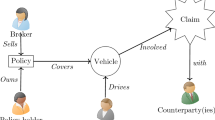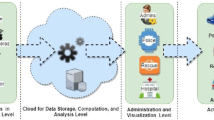Abstract
Monitoring the progress of auctions for fraudulent bidding activities is crucial for detecting and stopping fraud during runtime to prevent fraudsters from succeeding. To this end, we introduce a stage-based framework to monitor multiple live auctions for In-Auction Fraud (IAF). Creating a stage fraud monitoring system is different than what has been previously proposed in the very limited studies on runtime IAF detection. More precisely, we launch the IAF monitoring operation at several time points in each running auction depending on its duration. At each auction time point, our framework first detects IAF by evaluating each bidder’s stage activities based on the most reliable set of IAF patterns, and then takes appropriate actions to react to dishonest bidders. We develop the proposed framework with a dynamic agent architecture where multiple monitoring agents can be created and deleted with respect to the status of their corresponding auctions (initialized, completed or cancelled). The adoption of dynamic software architecture represents an excellent solution to the scalability and time efficiency issues of IAF monitoring systems since hundreds of live auctions are held simultaneously in commercial auction houses. Every time an auction is completed or terminated, the participants’ fraud scores are updated dynamically. Our approach enables us to observe each bidder in each live auction and manage his fraud score as well. We validate the IAF monitoring service through commercial auction data. We conduct three experiments to detect and react to shill-bidding fraud by employing datasets acquired from auctions of two valuable items, Palm PDA and XBOX. We observe each auction at three-time points, verifying the shill patterns that most likely happen in the corresponding stage for each one.












Similar content being viewed by others
References
Abedinzadeh S, Sadaoui S (2013) A Rough Sets-based Agent Trust Management Framework. Inter J Intel Syst Appl 5(4):1–19. doi:10.5815/ijisa.2013.04.01
Balingit R., Trevathan J., Lee Y., Read W. (2009) A software tool for collecting data from online auctions. In: Proceedings the 6 th International Conference on Information Technology: New, Generations, pp. 922–927. doi:10.1109/ITNG.2009.147
Braubach L, Pokahr A, Lamersdorf W (2005) Jadex: A BDI-Agent System Combining Middleware and Reasoning. In: Umland R, Klusch M, Calisti M (eds) Software Agent-Based Applications, Platforms, and Development Kits, Whitestein Series in Software Agent Technology, pp 143-168. doi:10.1007/1.1.115.8533
Bryan D, Lucking-Reiley D, Prasad N, Reeves D (2007) Pennies from eBay: The Determinants of Price in Online Auctions. J Ind Econ 55(2):223–233. doi:10.1111/j.1467-6451.2007.00309.x
Buccafurri F, Comi A, Lax G, Rosaci D (2016) Experimenting with Certified Reputation in a Competitive Multi-Agent Scenario. IEEE Intell Syst 31(1):48–55. doi:10.1109/MIS.2015.98
Cauwenberghs G, Poggio T (2001) Incremental and Decremental Support Vector Machine Learning. Adv Neural Inf Proces Syst 13:409–415. doi:10.1007/1.1.92.2608
Chang W., Chang J. S. (2011) A novel two-stage phased modeling framework for early fraud detection in online auctions. Expert Syst Appl 38(9):11244–11260. doi:10.1016/j.eswa.2011.02.172
Chau D, Pandit S, Faloutsos C (2006) Detecting Fraudulent Personalities in Networks of Online Auctioneers. The Tenth European Conference on Principles and Practice of Knowledge Discovery in Database, pp. 103-114. doi:10.1007/11871637_14
Dong F, Shatz SM, Xu H, Majumdar D (2012) Price comparison: A reliable approach to identifying shill bidding in online auctions Electron Commer Res Appl 11(2):171–179. doi:10.1016/j.elerap.2011.12.003
Dong F, Shatz SM, Xu H (2010) Reasoning under Uncertainty for Shill Detection in Online Auctions Using Dempster-Shafer Theory. Int J Softw Eng Knowl Eng 20(7):943–973. doi:10.1142/S0218194010005018
Dong F, Shatz S, Xu H (2009) Combating online in-auction frauds: Clues, techniques and challenges. Comput Sci Review 3(4):245–258. doi:10.1016/j.cosrev.2009.09.001
Engelberg J, Williams JJ (2009) eBay’s proxy bidding: A license to shill. J Econ Behavior Organ 72 (1):509–526. doi:10.1016/j.jebo.2009.05.023
Ford BJ, Xu H, Valova I (2013) A Real-Time Self-Adaptive Classifier for Identifying Suspicious Bidders in Online Auctions. Comput J 56(5):646–663. doi:10.1093/comjnl/bxs025
Ford BJ, Xu H, Valova I (2010) Identifying Suspicious Bidders Utilizing Hierarchical Clustering and Decision Trees. In: Proc. of the International Conference on Artificial Intelligence ICA, pp. 195–201. doi:10.1007/1.1.192.2764
Goel A, Xu H, Shatz SM (2010) A Multi-State Bayesian Network for Shill Verification in Online Auctions. In: Proc. of the 22nd Int. Conf. on Software Engineering and Knowledge Engineering, USA, pp. 279–285. doi:10.1007/1.1.189.1213
IC3 The Internet Crime Complaint Center (IC3), http://www.ic3.gov, last accessed September 2015
Jank W., Shmueli G. (2010) Modeling Online Auctions. Wiley, New York
Kauffman R, Wood CA (2007) Irregular bidding from opportunism: an explanation of shilling in online auctions. Inf Syst Res 5:1–36. doi:10.1007/1.1.106.1076
Khomnota L, Lin J-L (2015) Detecting Fraudsters in Online Auction Using Variations of Neighbor Diversity. Inter J Engin Techn Innovation 5(3):156–16. doi:10.3390/e16052629
Grzegorz K, Sławomir B (2015) Identification of Shill Bidding for Online Auctions Using Anomaly Detection, New Trends in Intelligent Information and Database Systems, Studies in Computational Intelligence. doi:10.1007/978-3-319-16211-9_12
Lie B, Zhang H, Chen H, Liu L, Wang D (2012) A K-means Clustering Based Algorithm for Shill Bidding Recognition in Online Auction. In: 24th Chinese Control and Decision Conference, IEEE, pp. 939–943. doi:10.1109/CCDC.2012.6244147
Manikanteswari DSL, Swathi M, nagendranath MVSS (2013) Machine Learning Approach to Handle Fraud Bids. Inter J Development of Comput Sci Technol 1(5):56–61
Mundra A, Rakesh N (2013) Online Hybrid Model for Online Fraud Prevention and Detection. Intelligent Computing, Networking, and Informatics, pp. 805-815. doi:10.1007/978-81-322-1665-0_81
Patel R, Xu H, Goel A (2007) Real-Time Trust Management in Agent Based Online Auction Systems. In: Proceedings of the 19th International Conference on Software Engineering and Knowledge Engineering, pp. 244–250 . doi:10.1007/1.1.189.4463
Rao A, Georgeff M (1995) BDI Agents: from theory to practice. In: Lesser V (ed) Proc. of the First International Conference on Multi-Agent Systems, ICMAS, pp 312-319, USA. doi:10.1007/1.1.37.7970
Ravisankar P, Ravi V, Raghava Rao G, Bose I (2011) Detection of Financial Statement Fraud and Feature Selection using Data Mining Techniques. Decis Support Syst 50(2):491–500. doi:10.1016/j.dss.2010.11.006
Sadaoui S, Wang X, Qi D (2015) A Real-Time Monitoring Framework For Online Auctions Frauds. In: Current Approaches in Applied Artificial Intelligence. June 2015. Springer, pp 97–108
Shehory O, Sturm A (2014) Multi-agent Systems: A Software Architecture Viewpoint. J Agent-Oriented Softw Eng:57–78. doi:10.1007/978-3-642-54432-3_4
Sycara K (1998) Multiagent Systems. A Mag:79–92. doi:10.1609/amag.v19i2.1370
Trevathan J, Read W (2009) Detecting Shill Bidding in Online English Auctions. Handbook of research on social and organizational liabilities in information security:446–470. doi:10.1007/1.1.61.7728
Trevathan J, Read W (2007) Investigating Shill Bidding Behaviors Involving Colluding Bidders. J Comput 2(10):63–75. doi:10.4304/jcp.2.10.63-75
Trevathan J, Read W (2006) Undesirable and Fraudulent Behaviour in Online Auctions. In: Proc. of the International Conference on Security and Cryptography Conference, Portugal, pp. 450–458. doi:10.1007/1.1.61.7441
Tsang S, Koh Y, Dobbie G, Alam S (2014) Detecting online auction shilling frauds using supervised learning. Expert Syst Appl 41(6):3027–3040. doi:10.1016/j.eswa.2013.10.033
Tsang S, Dobbie G, Koh S (2012) Evaluating Fraud Detection Algorithms Using an Auction Data Generator. In: Proc. of IEEE 12th International Conference on Data Mining Workshops, pp. 332–339. doi:10.1109/ICDMW.2012.34
Wang Y, Zhang J, Vassileva J (2014) A super-agent-based framework for reputation management and community formation in decentralized systems. Comput Intell 30(4):722–751. doi:10.1111/coin.12026
Wong H, Sycara K (2000) A Taxonomy of Middle Agents for the Internet. doi:10.1007/1.1.43.6078
Wooldridge M, Jennings NR (1995) Intelligent Agents: Theory and Practice. Knowledge Eng Rev 10 (2):115–152. doi:10.1007/1.1.55.2702
Xu H, Bates C, Shatz SM (2009) Model Checking for Shill Detection in Live Online Auctions. In: Software Engineering Research and Practice, pp. 134–140. doi:10.1007/1.1.529.5339
Xu H, Shatz SM, Bates CK (2008) A Framework for Agent-Based Trust Management in Online Auctions. ITNG:149–155. doi:10.1109/ITNG.2008.22
Yoshida T, Ohwada H (2010) Shill Bidder Detection for Online Auctions, PRICAI 2010: Trends in Artificial Intelligence, pp. 351-358. doi:10.1007/978-3-642-15246-7_33
Yu C, Lin S (2013) Fuzzy rule optimization for online auction frauds detection based on genetic algorithm. Electron Commer Res 13(2):169–182. doi:10.1007/s10660-013-9113-4
Yu C-H, Lin S-J (2008) Parallel Crawling and Capturing for On-Line Auction. In: Yang et al. (ed) LNCS, Vol. 5075, workshops, pp. 455-466. doi:10.1007/978-3-540-69304-8_48
Author information
Authors and Affiliations
Corresponding author
Rights and permissions
About this article
Cite this article
Sadaoui, S., Wang, X. A dynamic stage-based fraud monitoring framework of multiple live auctions. Appl Intell 46, 197–213 (2017). https://doi.org/10.1007/s10489-016-0818-7
Published:
Issue Date:
DOI: https://doi.org/10.1007/s10489-016-0818-7




